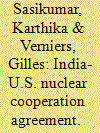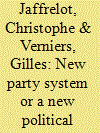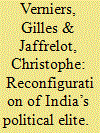|
|
|
Sort Order |
|
|
|
Items / Page
|
|
|
|
|
|
|
| Srl | Item |
| 1 |
ID:
173326


|
|
|
|
|
| Summary/Abstract |
Five aspects of the BJP's election campaign contributed to its success in 2019. The first is the personal appeal of the prime minister, which again played a major role, like it did in 2014, as Narendra Modi led a hyper-personalized campaign. Second, this campaign focused on security-related themes which were especially relevant in the context of the India-Pakistan tensions. Third, the BJP campaign strategy was backed by the most formidable election campaign machinery assembled by any party in India since Independence. Fourth, the BJP saturated the public space with the prime minister's image, adroitly using the traditional mainstream media as well as social media. The party used religious appeal to address its core base of supporters while projecting the prime minister's image as a protector and sentinel. Fifth, the latter three aspects of the BJP's campaign were fuelled by unprecedented levels of campaign expenditure and by the opacity of political funding in India, which the BJP had made more impenetrable through the introduction of electoral bonds. The combination of these factors show that the 2019 elections were not business as usual; their singularity largely due to the decline of institutions regulating the electoral process, including the Election Commission of India.
|
|
|
|
|
|
|
|
|
|
|
|
|
|
|
|
| 2 |
ID:
123216


|
|
|
|
|
| Publication |
2013.
|
| Summary/Abstract |
The U.S.-India civil nuclear energy agreement triggered a contentious debate in India from 2005 to 2008. Regional political actors played crucial and unanticipated roles in the debate. We present explanations for the positions adopted by the main actors and the level of contention. We find that parties' positions were driven not by ideology but by the compulsions of coalition politics.
|
|
|
|
|
|
|
|
|
|
|
|
|
|
|
|
| 3 |
ID:
173325


|
|
|
|
|
| Summary/Abstract |
Defying many odds, the BJP has held on to the political space it conquered five years ago and succeeded in expanding its territorial imprint. It did so through a campaign that was substantially different from the 2014 General Election campaign, which was marked by the rejection of the Congress and an enthusiastic embrace of the BJP’s promise of development for all. Five years later, much has changed in India with regard to the political system, which has become more centralized and less liberal. Since the 2019 election, the second Modi-led government has pushed the transition from a de facto Hindu majoritarian state towards a de jure Hindu majoritarian state through the adoption of controversial policies affecting some of the basic normative tenets of India’s old constitutional order, so much so that the BJP’s rise to power has transformed not only the party system, but also the political system itself. This is reflected in India dropping several ranks in most indices of democracy. At the same time, Indian national and state politics have followed divergent paths: the BJP dominates the national stage unchallenged by any rival, but is finding it increasingly difficult to sustain its sway in state elections – leaving the question of the Hindu nationalist hegemony open.
|
|
|
|
|
|
|
|
|
|
|
|
|
|
|
|
| 4 |
ID:
173331


|
|
|
|
|
| Summary/Abstract |
The rise of the BJP in national and state politics is often associated with a representation skewed toward traditional elite groups and the marginalisation of groups associated with other parties, such as minorities and various dominant OBC groups. This article examines the transformation of the sociological composition of the Lok Sabha over time and seeks to assess its elitist character, by providing descriptive statistics on five socio-demographic and economic variables: caste, religion, gender, dynasticism, wealth and occupation. Data suggests that political representation in India has by and large always been skewed toward the elites, but the composition of these elites has changed over time. For instance, the recent surge in the representation of the upper caste in the Lok Sabha pre-dates the rise of the BJP in 2014, and the marginalisation of minorities and women is a long-standing phenomenon. Since 2014 however, the BJP has contributed to enhancing a particular form of elite – those rooted in local and regional business networks.
|
|
|
|
|
|
|
|
|
|
|
|
|
|
|
|
|
|
|
|
|